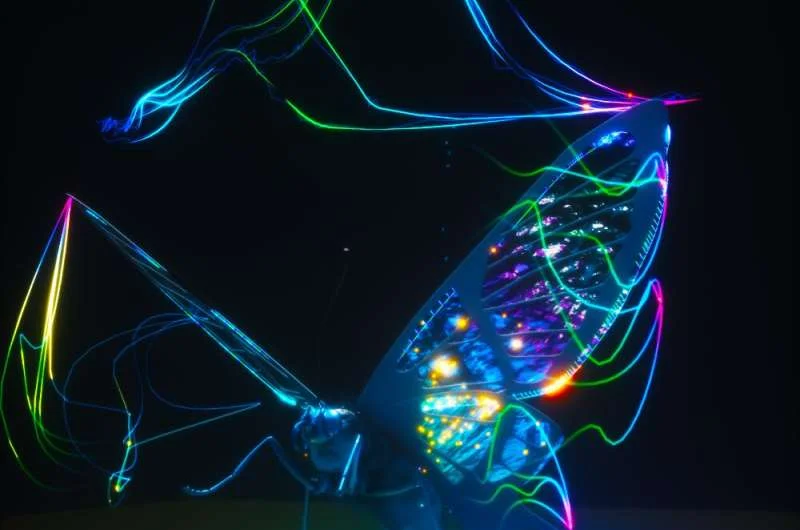There are many creatures on our planet with more developed senses than humans. Turtles can sense the earth’s magnetic field. Praying mantis shrimp can detect polarized light. Elephants can hear much lower frequencies than humans. Butterflies can detect a wider range of colors, including ultraviolet (UV) light.
Inspired by the advanced visual system of the Papilio xuthus butterfly, a research team has developed an image sensor capable of “seeing” in the ultraviolet range, beyond the reach of the human eye. The design of the sensor uses multilayer photodiodes and perovskite nanocrystals (PNC), which can create images at different wavelengths in the UV range. Using spectral signatures of biomedical markers such as amino acids, this new imaging technology can distinguish cancer cells from normal cells with 99% confidence.
This new research, led by Victor Gruev, professor of electrical and computer engineering, and Shuming Ni, professor of bioengineering at the University of Illinois at Urbana-Champaign, was recently published in the journal Science. Science Developments.
minor variations
“We were inspired by the visual system of butterflies, which can detect various areas of the ultraviolet spectrum, and developed a camera that mimics this function,” says Gruev. “We did this using new perovskite nanocrystals combined with silicon imaging technology, and this new camera technology can detect multiple UV regions.”
UV light is electromagnetic radiation with a wavelength shorter than visible light (but longer than X-rays). We are most familiar with the sun’s ultraviolet radiation and its dangers to human health. Ultraviolet light is divided into three different regions: UVA, UVB and UVC, depending on different wavelength ranges. Because humans cannot see UV light, it is difficult to learn about UV, especially to notice the small differences between each region.
But butterflies can see these tiny changes in the UV spectrum, just as humans can see shades of blue and green. “It’s very interesting to me how they can see these small differences,” Gruev notes. “UV light is incredibly difficult to capture, it is absorbed by everything, and butterflies have managed to do this extremely well.”
“Imitation” game
Humans have trichromatic vision, with three photoreceptors in which each perceived color can be created from a combination of red, green, and blue. However, butterflies have complex eyes with six (or more) classes of photoreceptors with different spectral sensitivities. In particular, the yellow Asian mahogany butterfly, Papilio xuthus, has not only blue, green, and red receptors, but also violet, ultraviolet, and broadband receptors. Additionally, butterflies have fluorescent pigments that allow them to convert ultraviolet light into visible light, which is then easily detected by their photoreceptors. This allows them to perceive a wider range of colors and details of the environment.
In addition to increasing the number of photoreceptors, butterflies also exhibit the unique multilayered structure of their photoreceptors. To replicate the UV sensing mechanism of the Papilio xuthus butterfly, the UIUC team simulated this process by combining a thin layer of PNC with a multilevel silicon photodiode array.
PNCs are a class of semiconductor nanocrystals that exhibit unique properties similar to quantum dots; Changing the size and composition of the particles changes the absorption and emission properties of the material. Over the past few years, PNCs have become an interesting material for various sensors such as solar cells and LEDs. PNCs are extremely good at detecting UV (and even lower) wavelengths than traditional silicon detectors. In the new image sensor, the PNC layer can absorb UV photons and re-emit light in the visible (green) spectrum; This is then detected by multilayer silicon photodiodes. Processing of these signals allows UV signatures to be visualized and identified.
Healthcare and not only
Various biomedical markers are present in higher concentrations in cancer tissues than in healthy tissues; amino acids (building blocks of proteins), proteins and enzymes. When excited by UV light, these markers light up and emit fluorescent light in the UV and part of the visible spectrum in a process called autofluorescence. “Imaging in the ultraviolet range was limited, and I would say that was the biggest obstacle to scientific progress,” Nee explains. “We have developed this technology with which we can now image UV light with high precision and also distinguish small differences in wavelength.”
Since cancer and healthy cells have different marker concentrations and therefore different spectral signatures, the two classes of cells can be distinguished based on their fluorescence in the UV spectrum. The team evaluated the imaging devices for their ability to distinguish cancer-related markers and found that they could distinguish between cancerous and healthy cells with 99% confidence.
Gruev, Ni, and the collaborative research team envision the possibility of using this sensor during surgery. One of the biggest challenges is knowing how much tissue needs to be removed to ensure clear margins, and such a sensor could help streamline the decision-making process when a surgeon is removing a cancerous tumor.
“This new imaging technology allows us to distinguish cancer cells from healthy cells, opening up new and exciting applications beyond health,” says Nee. Besides butterflies, there are many other species that can see ultraviolet radiation, and having a way to detect this light will provide interesting opportunities for biologists to learn more about these species, such as their hunting and mating habits. Moving the sensor underwater can also help get a better understanding of the environment. Although water absorbs a lot of UV radiation, this is still enough to have an effect, and there are many animals that can see and use UV light underwater. Source
Source: Port Altele
